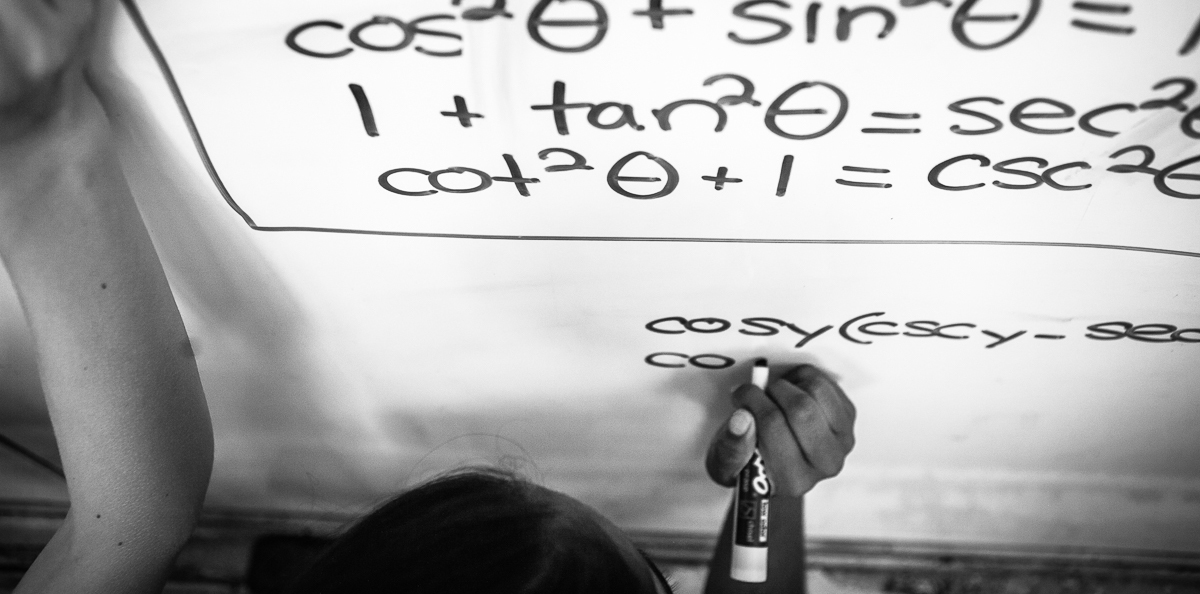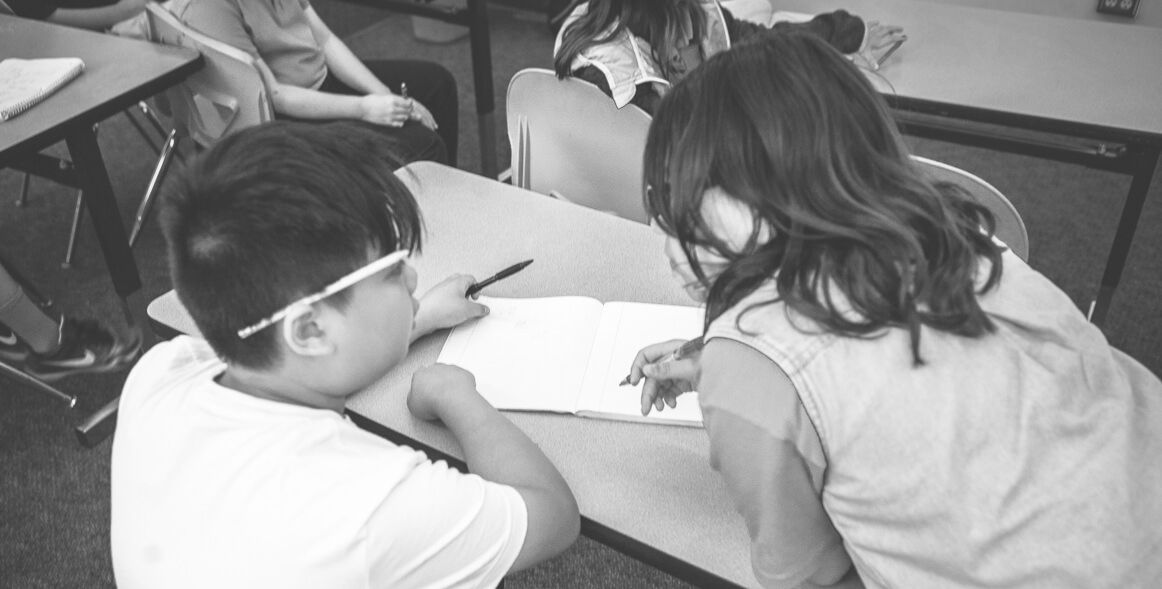
our current curriculum offering
6th-grade curriculum
The 6th Grade Math Academy curriculum is equivalent to Accelerated Integrated Math I/II and is the first course of a two course sequence. It is rapid acceleration on the Integrated Math I Honors and Math II Honors courses. The content includes all of the standards from the CCSS Integrated Math I, half the standards from the CCSS Integrated Math II and some introductory standards from SSCC Mathematics Integrated III. The course also includes instruction in competition-style problem solving mathematics techniques and an introduction to proof-based mathematics. The course strengthens and builds upon students’ prior knowledge from middle school mathematics standards. The overall strategy is to first develop algebraic technique to a high degree and then to study other topics (such as graphing, geometry and trigonometry) from that vantage point. Students are taught to solve equations and then made to apply this knowledge to a wide variety of situations.
7th-Grade Curriculum
The 7th grade Math Academy curriculum is equivalent to Accelerated Math II/III and is the second course of a two course sequence. It is rapid acceleration of the Integrated Math II Honors and Math III Honors. The content includes half the standards from the CCSS Integrated Math II course and all standards from CCSS Mathematics Integrated III in addition to the continuation of competition math skills, foundational college level proofs and pre-calculus. While much of the Algebra treated will be a review of what was done in 6th grade, there will be a greater emphasis on depth. Students will be required to prove many of the basic algebraic facts they used in 6th grade (for example, the laws of logarithms). There will also be more emphasis on solving systems of equations, including basic linear algebra. Students will use their knowledge of geometry and trigonometry to study complex numbers in more depth. A significant part of the 7th grade material will encompass precalculus. This course strengthens and builds upon students’ prior knowledge from Accelerated Mathematics I/II.
These two courses follows the suggested option of the Common Core State Standards Integrated Pathway model for acceleration by compacting three years of content into a two year time period.
8th-Grade Curriculum
The 8th grade Math Academy curriculum is devoted to Calculus (both differential and integral). This foundational course in mathematics is taught at most four year colleges in the first year. It the base of many branches of mathematics and the sciences. The course will follow curriculum designed to prepare students for the AP BC Calculus exam taken at the end of the school year. It will solidify competition math skills and proof-based mathematics. This course strengthens and builds upon students’ prior knowledge from Accelerated Math II/III.
High School Curriculum
The high school curriculum is in the development process and will consist of a combination of theoretical and applied mathematics similar to what the students would experience in a collegiate undergraduate math program. The courses have been approved by the University of California as sequenced, for-credit courses meeting a-g requirements. These courses will be taught by credentialed instructors with a minimum of a master's degree in mathematics and experience teaching at the undergraduate level.
9th-Grade Curriculum
Multivariable Calculus – Building on single-variable calculus, gives an introduction to multivariable (or ’vector’) calculus. Topics include different types of integrals (line, double, surface, triple) and derivatives (partial, directional, total); the famous div, grad and curl operators; why the chain rule is easy and fun; the all-time best version of the fundamental theorem of calculus (by Stokes); and an answer to the vexing question: “What is dx?’. Applications heavily emphasized.
Recommended text: Saturnino Salas, Einar Hille, Garrett Etgen. Calculus, One and Several Variables. New York, NY: John Wiley and Sons.
Linear Algebra – Emphasizes vector spaces and linear transformations. Linear independence and bases, null spaces and ranks of linear transformations, the algebra of linear transformations, the representation of linear transformations by matrices. Additional topics may include Gaussian elimination, inner product spaces; determinants, eigenvalues; and applications of linear algebra.
Recommended text: Linear Algebra and its Applications by David C. Lay, Steven R. Lay and Judy J. McDonald.
Creative Inquiry – This is a research course. It will involve small-group learning, an imaginative combination of engaged learning and undergraduate research. Students take on problems that spring from their own curiosity, from an instructor’s challenge or from the pressing needs of the world around them. Team-based investigations are led by a faculty mentor and typically span two to four semesters. Students take ownership of their projects and take the risks necessary to solve problems and get answers. Topics are boundless. It is hoped that students present their work at national conferences, fielding questions from professionals. This invaluable experience produces exceptional graduates. Our Creative Inquiry participants develop critical thinking skills, learn to solve problems as a team and hone their communication and presentation skills.
10th-Grade Curriculum
Discrete Mathematics – An introduction to the techniques and ideas of combinatorics including counting methods, generating functions, Ramsey theory, graphs, networks and extrenal combinatorics.
Recommended text: Chen Chuan-Chong and Koh Khee-Meng, Principles and Techniques in Combinatorics, World Scientific
Abstract Algebra – Covers basic structures which appear throughout mathematics including groups and rings. Topics in group theory will include isomorphism theorems, orbits and stabilizers and coset partitions. Topics in ring theory will include ideals, quotient rings and prime and maximal ideals. Ring and field extensions may also be introduced. Applications to coding theory, number theory and cryptography will be included.
Recommended text: Pinter, Charles C. (1990). A Book of Abstract Algebra. Boston, MA: McGraw-Hill Higher Education.
Differential Equations and Modeling – Introduction to the theory of ordinary differential equations, with applications to modeling in the physical, biological and social sciences. Emphasis on the qualitative study of differential equations via analytic methods or numerical techniques using standard mathematical software packages. A good understanding of the theory of vector spaces and linear transformations is assumed.
Recommended Text: Differential Equations, Fourth Edition Paul Blanchard, Robert L. Devaney, Glen R. Hall.
Creative Inquiry – See above for description.
11th-Grade Curriculum
Probability and Statistics – Probability spaces, discrete and continuous random variables, conditional and marginal distributions, independence, expectation, generating functions, transformations, central limit theorem. Frequency Distributions, Data Description, Probability and Counting Rules, Discrete Probability Distributions, The Normal Distribution, Confidence Intervals, and Sample Size, Hypothesis Testing, Correlation and Regression, Chi-square tests, Analysis of Variance, Nonparametric statistics, Sampling, and Simulation.
Recommended Texts: Elementary Statistics, a Step by Step Approach by Allan Bluman. Sheldon Ross: A First Course in Probability, Prentice Hall
Introduction to Topology and Real Analysis – A course on how to write proofs in the context of analysis and point-set topology. Focus on the construction and presentation of rigorous proofs. Learn how to use the language of analysis and topology to prove results about sequences, limits, and continuity. An introduction to elementary measure theory.
Recommended Texts: Understanding Analysis (Undergraduate Texts in Mathematics) 2nd ed. 2015, Corr. 2nd printing 2016 Edition by Stephen Abbott. Topology by James R. Munkres. Measures, Integrals and Martingales by Rene L. Schilling.
Graphs and Algorithms - Topics include sorting and searching, problems such as shortest path and network flow, and topics selected from arithmetic circuits, parallel algorithms, computational geometry, and others. An introduction to computational complexity, NP-completeness, and approximation algorithms.
Recommended text: Introduction to Algorithms, 3rd Edition by Cormen, Leiserson, Rivest, and Stein.
Creative Inquiry – See above for description.
12th-Grade Curriculum
Numerical Analysis– Topics covered: root-finding, interpolation, and polynomial approximation, numerical differentiation, and integration, initial value problems and ordinary differential equations, direct and iterative methods for solving linear systems of equations, partial differential equations.
Recommended Text: Burden and Faires, Numerical Analysis, Thomson/Brooks Cole
Differential Geometry- Topics include: Calculus in Euclidean space, Frame Fields, Euclidean geometry, Calculus on a surface, Shape operators, the geometry of surfaces in R3, Riemannian Geometry and Global structure of surfaces.
Recommended text: Barrett O’ Neil, Elementary Differential Geometry
Functions of a Complex Variable – Topics may include: Cauchy Riemann equations, harmonic functions, Cauchy’s theorem, Liouville’s theorem, Cauchy’s Integral Formula, maximum modulus principle, argument principle, Rouche’s theorem, series expansions, isolated singularities, calculus of residues and conformal mapping.
Recommended text: John B. Conway, Functions of One Complex Variable, Springer.
Creative Inquiry – See above for description.
Mathematical Standards
The expertise that instructors in the Math Academy should aim to develop in their students include those described in the Standards for Mathematical Practice.
These include:
- Make sense of problems and persevere in solving them.
- Reason abstractly and quantitatively.
- Construct viable arguments and critique the reasoning of others.
- Model with mathematics.
- Use appropriate tools strategically.
- Attend to precision.
- Look for and make use of structure.
- Look for and express regularity in repeated reasoning.
There is also heavy emphasis on communicating mathematics in all forms. Students should learn to become proficient at reading, writing, speaking and listening to mathematics. Each year students will be exposed to problems whose solution involves mathematical reasoning, a knowledge of proof techniques and writing clear proofs. Understanding proofs and proof techniques are heavily emphasized throughout.

Math Academy has 4 key goals
Goal #1
Improve students’ technical skills early.
Goal #2
Enhance the mathematical background by teaching them how their technical skills can be used to solve complicated problems that come up when studying our world.
Goal #3
Develop students’ problem-solving skills through active and interactive learning in a cooperative environment.
Goal #4
Enhance students’ communications skills through writing up problem solutions and presentations to their peers.
The math academy structure of instruction
1. In-Class Problem Sets
Students work in groups or by themselves on closely supervised problems. Sometimes they continue to work on the problem sets outside of class.
2. Class Presentations
Students are required to present solutions to problems as often as possible. In practice any given student gets to present solutions a few times per week and in some cases almost daily.
3. Math notebook
Students will neatly and carefully write up solutions to the in-class problems in a special notebook. The instructor does check these notebooks.
4. Homework Assignment
Most of the homework is assigned from our complementary online system: mathacademy.us. The software incorporates intelligent logic that customizes each student’s learning experience and the Math Academy pedagogy to ensure mastery learning. Material is heavily reviewed. Thus a typical homework assignment would contain problems on new material and also problems on material learned in the past. The system at mathacademy.us collects data from students’ past homework assignment. This data is used to determine the weak points of the students and assigns review topics accordingly. The instructor is also informed of those topics which need the most attention by a color code (green denotes excellent mastery, yellow denotes insufficient mastery and red denotes poor mastery). This valuable information is used to plan review sessions and to design future homework assignments.



